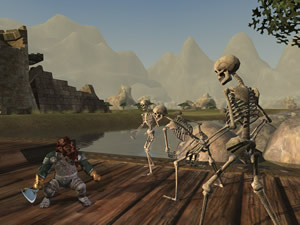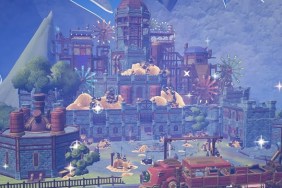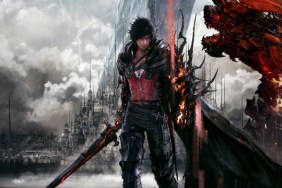The neverending story.
The original Everquest, released on March 16, 1999, was a tremendous moment for PC gaming in every way imaginable. It wasn’t the first massively-multiplayer online role-playing game, but it was certainly the biggest. There were 100,000 trees, for crying out loud. Trees! The game was so big it managed to eclipse people’s entire lives, earning it the moniker "Evercrack" and spawning support groups for Everquest victims and their loved ones, such as Everquest Widows and Online Gamers Anonymous.
With roughly 450,000 customers and revenue near one billion dollars, it didn’t take long for other companies to take interest in the burgeoning MMORPG phenomenon. Sony Online Entertainment, Everquest‘s publisher and developer, appeared poised to crush the usurpers when Star Wars: Galaxies was announced, until that one miraculously flopped like a Hutt on a hot sidewalk, leaving a gaping hole in the MMO market. With Blizzard’s World of Warcraft looming, we assumed that Everquest II would be a bid on Sony’s part to pick up the pieces and re-establish its online dynasty.
But instead, Everquest II seems to have been designed with the hardcore, non-competitive role-player in mind. While this means great things for the explorers, achievers and socializers out there, the killers will feel left out in the cold (to find out where you fit in, click here) due to the fact that there is no Player versus Player combat, of any shape or form, to be found anywhere in Everquest II. You can’t even duel, much less gank, grief or corpse-camp.
Still, Everquest II isn’t built for newbies. The game does include a basic tutorial and a small island where first-timers can get their bearings, but nothing will prepare them for the humongous, sprawling city they’ll be swallowed up by after they leave the comforts of Noob Island
Instead, the detailed plot, plethora of quests, long-winded NPCs, massive world, rare items, involved item-crafting systems, and absence of Player Killer (like me) make Everquest II one of the most inviting role-play sanctuaries known to online gaming. Only the hardest-hearted fiends will have the patience and creativity needed to screw other players, and a large percentage of the adolescent contingent will be frustrated quickly in the game’s opening hours. In turn, Everquest II is not an MMORPG with something for everybody, but boy, there’s a lot here.
Little has happened in the lands of Norrath since the last game. Creatures large and small still stalk the countryside, while the cities of Freeport and Qeynos bustle with commerce, adventurers, and refugees. The refugees are the product of a little cataclysm in which the moon exploded and rained fiery death all over the place, but that’s hardly worth mentioning. You are one such refugee, and you’re immigrating to either Qeynos (if you’re good) or Freeport (if you’re evil) to begin a new life as a hero-to-be.
Of course, before you get to spell-casting and sword-swinging, you must create an identity. Your name must contain only letters, the first of which must be a capital, the rest of which must be lower-case, rendering our first choice, "T3h PwNz0rZ," impractical. The races include several varieties of elves, humans, gnomes, halflings, trolls, rat people, cat people, ogres, barbarians, frog people and humans, while the sexes mildly alter NPC reactions and little else.
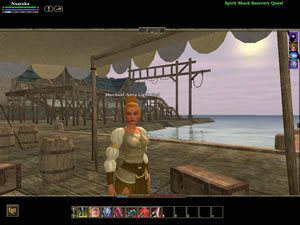 The character creator allows you to play with a couple major details, such as hairstyle, skin color and height, and a ton of smaller ones such as jaw width, thickness, and length. However, upon entering the game world you’ll discover that the tilt and elevation of your eyebrows, which you tortured yourself over, are of no consequence and that all members of a given race look largely the same from a distance. What at first seems like a detailed character creator is in reality a somewhat dull one incognito.
The character creator allows you to play with a couple major details, such as hairstyle, skin color and height, and a ton of smaller ones such as jaw width, thickness, and length. However, upon entering the game world you’ll discover that the tilt and elevation of your eyebrows, which you tortured yourself over, are of no consequence and that all members of a given race look largely the same from a distance. What at first seems like a detailed character creator is in reality a somewhat dull one incognito.
After creating your character, you choose a moral disposition, which affects the tone of the city you’ll wander around in as well as a few quests. However, these opposing alignments seem unnecessary given the absence of PvP. Gesturing rudely at the bad guys just isn’t as thrilling as rolling one of their farming parties or harassing their noobs.
From there you’ll enter a brief tutorial aboard a ship that covers the nuts and bolts of movement, speaking, buying, and fighting. Thankfully, there is an option to skip this segment if you think you know what you’re doing. The ship takes you to a refuge where you’re introduced to crafting, item collection and grouping.
Then it’s on to the big city of your choosing. You’ll be immediately led by a glowing trail to the inn, where you’ll get your room and meet your landlady. She’ll give you a couple pieces of furniture that you may place in your room as you see fit, and then you’ll have to go complete a few delivery quests on her behalf. Until you do so, you won’t be able to advance past level seven, so if you decide to drop into the sewers for a bit of monster hunting, your fun will be cut short quickly and you won’t immediately understand why.
Once you figure out how to become a citizen and complete the first set of required quests, the entire city opens up to you, and you’ll have no idea where to go. Most of your quests are delivery errands; you’ll basically have to run all over the city talking to every citizen you meet. The NPCs have a lot to say, and if they have a quest for you they’ll probably even say it out loud.
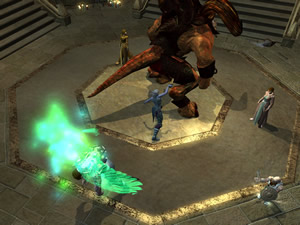 When you address an NPC, their response will pop up in a dialogue window. If you can reply, smaller dialogue boxes will also pop up. If more than one of these appears, you have a quest on your hands. Since you have to talk to NPCs to get quests and since there are a million NPCs, you’ll wind up just clicking on everyone in sight and scanning for the "I’ll take it" responses.
When you address an NPC, their response will pop up in a dialogue window. If you can reply, smaller dialogue boxes will also pop up. If more than one of these appears, you have a quest on your hands. Since you have to talk to NPCs to get quests and since there are a million NPCs, you’ll wind up just clicking on everyone in sight and scanning for the "I’ll take it" responses.
Clearly, Sony wanted to force players to become somewhat immersed in the lives and stories of the townsfolk, as evidenced by the tremendous amount of back story and actual voiced character responses. However, this system ultimately fails in this aim and winds up being a waste of time compared to the far simpler route of grabbing quests from an adventurer’s guild.
At any rate, you’ll pick up loads of quests as you wander through your huge city and its many zones. You can have up to fifty quests active at any one time, so to keep things somewhat organized, you have a journal that tells you where you got each quest and what you must do to complete it. The quests are further divided into the zones from which they originated. This poses a problem, though, because you actually want to know the opposite. When you’re in the Forest Ruins, you don’t want to know what quests you got in Southern Qeynos – you want to be able to quickly look at what quests can be completed in the Forest Ruins. Instead, you have to sit there and read through all your quests until you come to one that can be completed in your current zone.
Another problem with the quest system is that few will remember which ones they have active, which can make it difficult to get groups together for certain quests. This wouldn’t be a problem if quests could be shared within a group, but alas, they cannot.
There are four basic player classes in Everquest II: mage, priest, fighter, and scout. You’ll also be able to pick a profession at level 10 and a subclass at level 20. You won’t be able to level up past 10 until you choose a profession, and the "profession" NPCs aren’t always easy to find. On the flip-side, there are a lot of classes and jobs to choose from, so chances are you’ll be able to find one that’s just right for you. Keep in mind, though, that some classes may only be played by certain alignments, so don’t join the good side if you want to become an assassin. Your race, however, has no bearing on what classes you may become, which is a nice change from the original.
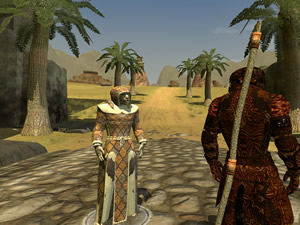 The combat in Everquest II will be instantly familiar to anyone who has ever played an RPG. You target an enemy, attack, and click on various special moves as the battle progresses. In groups, warriors still taunt and tank, while healers buff and cure and mages nuke, dot and debuff. In a new twist, your party will occasionally be presented with a Heroic Opportunity. When this happens an icon will appear in the bottom right hand of the screen accompanied by a couple symbols. These symbols correspond with various abilities, and if your party can execute them all, it will be granted a boon.
The combat in Everquest II will be instantly familiar to anyone who has ever played an RPG. You target an enemy, attack, and click on various special moves as the battle progresses. In groups, warriors still taunt and tank, while healers buff and cure and mages nuke, dot and debuff. In a new twist, your party will occasionally be presented with a Heroic Opportunity. When this happens an icon will appear in the bottom right hand of the screen accompanied by a couple symbols. These symbols correspond with various abilities, and if your party can execute them all, it will be granted a boon.
Crafting has taken on increased significance in Everquest II as you will be able to assume a crafting profession and gain skills to aid in your work. Much like the regular classes, you may initially choose between crafts, outfitting, and scholarship and then, for example, move into armor smithing, weapon smithing, or tailoring. You’ll have to venture into the world for raw materials, buy recipes, and then sit down at a work bench or mannequin to create your item.
Since Everquest II is focused more on cooperation than competition, guilds are given quests in the form of writs by Heralds. By completing more and more writs, guilds gain status within their city and renown abroad. While we would have loved to have seen some guild vs. guild wars, the guild quests are a great idea and should certainly keep dedicated guild-mates busy until their husbands, wives and children leave them.
Not that dedicated EQ II players will notice, because Everquest II‘s environments look great, as do its large structures. Players and NPCs are all nicely detailed and animated thanks to good motion-capture, and the game’s lighting effects are excellent. While there are some very large zones that stream into one another, running around town can be a chunky process and the significant loading times will do little for your sense of otherworldly immersion. But have no doubt; Everquest II has the most impressive virtual vistas of any MMO to date.
 Like its graphics, the game’s sounds are a mixed bag. The authentic NPC voices are mostly done well, and the epic, orchestral scores are beautifully mastered and appropriate for their situations. Some of the sound effects, though, are a little funky. Every time you jump your character will make a weird, constipated grunt. Too bad no shops sell fiber bars.
Like its graphics, the game’s sounds are a mixed bag. The authentic NPC voices are mostly done well, and the epic, orchestral scores are beautifully mastered and appropriate for their situations. Some of the sound effects, though, are a little funky. Every time you jump your character will make a weird, constipated grunt. Too bad no shops sell fiber bars.
It should also be noted that if you want to enjoy EQ II, you better have a good rig. The game comes on 9 CDs and takes up a whopping 7 GB on your hard drive. If you want to enjoy the pretty pictures, you’ll need at least 512 MB RAM and a fairly new video card.
It’s always tough reviewing MMORPGs since they tend to morph and change dramatically over time, but it’s safe to say that Everquest II is a solid effort. It takes place in a gigantic world with loads of great content, and the seemingly endless number of small quests means that if you only have a half-hour to play, you can actually get something done. However, Everquest II isn’t terribly intuitive or noob-friendly when you’re just starting out, its questing system could use some real improvements, and the lack of any PvP is a bummer to the bloodthirsty savages at GR. So provided you like to role-play and have a lot of time on your hands, you should definitely give Sony’s latest quest a long, hard Care Bear stare.
